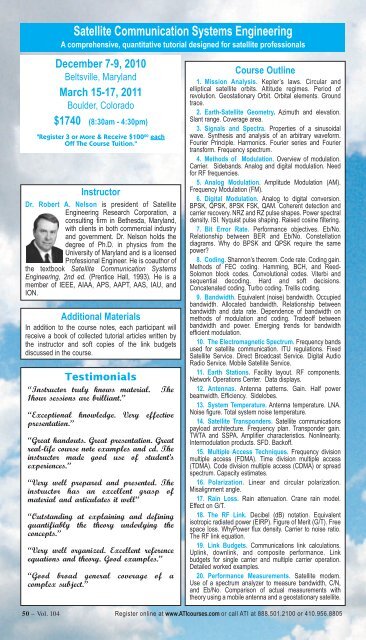Systems Engineering - ATI
Systems Engineering - ATI
Systems Engineering - ATI
Create successful ePaper yourself
Turn your PDF publications into a flip-book with our unique Google optimized e-Paper software.
Satellite Communication <strong>Systems</strong> <strong>Engineering</strong><br />
A comprehensive, quantitative tutorial designed for satellite professionals<br />
December 7-9, 2010<br />
Beltsville, Maryland<br />
March 15-17, 2011<br />
Boulder, Colorado<br />
$1740 (8:30am - 4:30pm)<br />
"Register 3 or More & Receive $100 00 each<br />
Off The Course Tuition."<br />
Instructor<br />
Dr. Robert A. Nelson is president of Satellite<br />
<strong>Engineering</strong> Research Corporation, a<br />
consulting firm in Bethesda, Maryland,<br />
with clients in both commercial industry<br />
and government. Dr. Nelson holds the<br />
degree of Ph.D. in physics from the<br />
University of Maryland and is a licensed<br />
Professional Engineer. He is coauthor of<br />
the textbook Satellite Communication <strong>Systems</strong><br />
<strong>Engineering</strong>, 2nd ed. (Prentice Hall, 1993). He is a<br />
member of IEEE, AIAA, APS, AAPT, AAS, IAU, and<br />
ION.<br />
Additional Materials<br />
In addition to the course notes, each participant will<br />
receive a book of collected tutorial articles written by<br />
the instructor and soft copies of the link budgets<br />
discussed in the course.<br />
Testimonials<br />
“Instructor truly knows material. The<br />
1hour sessions are brilliant.”<br />
“Exceptional knowledge. Very effective<br />
presentation.”<br />
“Great handouts. Great presentation. Great<br />
real-life course note examples and cd. The<br />
instructor made good use of student’s<br />
experiences.”<br />
“Very well prepared and presented. The<br />
instructor has an excellent grasp of<br />
material and articulates it well”<br />
“Outstanding at explaining and defining<br />
quantifiably the theory underlying the<br />
concepts.”<br />
“Very well organized. Excellent reference<br />
equations and theory. Good examples.”<br />
“Good broad general coverage of a<br />
complex subject.”<br />
Course Outline<br />
1. Mission Analysis. Kepler’s laws. Circular and<br />
elliptical satellite orbits. Altitude regimes. Period of<br />
revolution. Geostationary Orbit. Orbital elements. Ground<br />
trace.<br />
2. Earth-Satellite Geometry. Azimuth and elevation.<br />
Slant range. Coverage area.<br />
3. Signals and Spectra. Properties of a sinusoidal<br />
wave. Synthesis and analysis of an arbitrary waveform.<br />
Fourier Principle. Harmonics. Fourier series and Fourier<br />
transform. Frequency spectrum.<br />
4. Methods of Modulation. Overview of modulation.<br />
Carrier. Sidebands. Analog and digital modulation. Need<br />
for RF frequencies.<br />
5. Analog Modulation. Amplitude Modulation (AM).<br />
Frequency Modulation (FM).<br />
6. Digital Modulation. Analog to digital conversion.<br />
BPSK, QPSK, 8PSK FSK, QAM. Coherent detection and<br />
carrier recovery. NRZ and RZ pulse shapes. Power spectral<br />
density. ISI. Nyquist pulse shaping. Raised cosine filtering.<br />
7. Bit Error Rate. Performance objectives. Eb/No.<br />
Relationship between BER and Eb/No. Constellation<br />
diagrams. Why do BPSK and QPSK require the same<br />
power<br />
8. Coding. Shannon’s theorem. Code rate. Coding gain.<br />
Methods of FEC coding. Hamming, BCH, and Reed-<br />
Solomon block codes. Convolutional codes. Viterbi and<br />
sequential decoding. Hard and soft decisions.<br />
Concatenated coding. Turbo coding. Trellis coding.<br />
9. Bandwidth. Equivalent (noise) bandwidth. Occupied<br />
bandwidth. Allocated bandwidth. Relationship between<br />
bandwidth and data rate. Dependence of bandwidth on<br />
methods of modulation and coding. Tradeoff between<br />
bandwidth and power. Emerging trends for bandwidth<br />
efficient modulation.<br />
10. The Electromagnetic Spectrum. Frequency bands<br />
used for satellite communication. ITU regulations. Fixed<br />
Satellite Service. Direct Broadcast Service. Digital Audio<br />
Radio Service. Mobile Satellite Service.<br />
11. Earth Stations. Facility layout. RF components.<br />
Network Operations Center. Data displays.<br />
12. Antennas. Antenna patterns. Gain. Half power<br />
beamwidth. Efficiency. Sidelobes.<br />
13. System Temperature. Antenna temperature. LNA.<br />
Noise figure. Total system noise temperature.<br />
14. Satellite Transponders. Satellite communications<br />
payload architecture. Frequency plan. Transponder gain.<br />
TWTA and SSPA. Amplifier characteristics. Nonlinearity.<br />
Intermodulation products. SFD. Backoff.<br />
15. Multiple Access Techniques. Frequency division<br />
multiple access (FDMA). Time division multiple access<br />
(TDMA). Code division multiple access (CDMA) or spread<br />
spectrum. Capacity estimates.<br />
16. Polarization. Linear and circular polarization.<br />
Misalignment angle.<br />
17. Rain Loss. Rain attenuation. Crane rain model.<br />
Effect on G/T.<br />
18. The RF Link. Decibel (dB) notation. Equivalent<br />
isotropic radiated power (EIRP). Figure of Merit (G/T). Free<br />
space loss. WhyPower flux density. Carrier to noise ratio.<br />
The RF link equation.<br />
19. Link Budgets. Communications link calculations.<br />
Uplink, downlink, and composite performance. Link<br />
budgets for single carrier and multiple carrier operation.<br />
Detailed worked examples.<br />
20. Performance Measurements. Satellite modem.<br />
Use of a spectrum analyzer to measure bandwidth, C/N,<br />
and Eb/No. Comparison of actual measurements with<br />
theory using a mobile antenna and a geostationary satellite.<br />
50 – Vol. 104 Register online at www.<strong>ATI</strong>courses.com or call <strong>ATI</strong> at 888.501.2100 or 410.956.8805

















